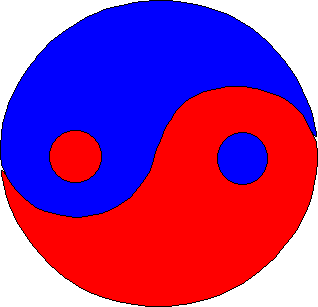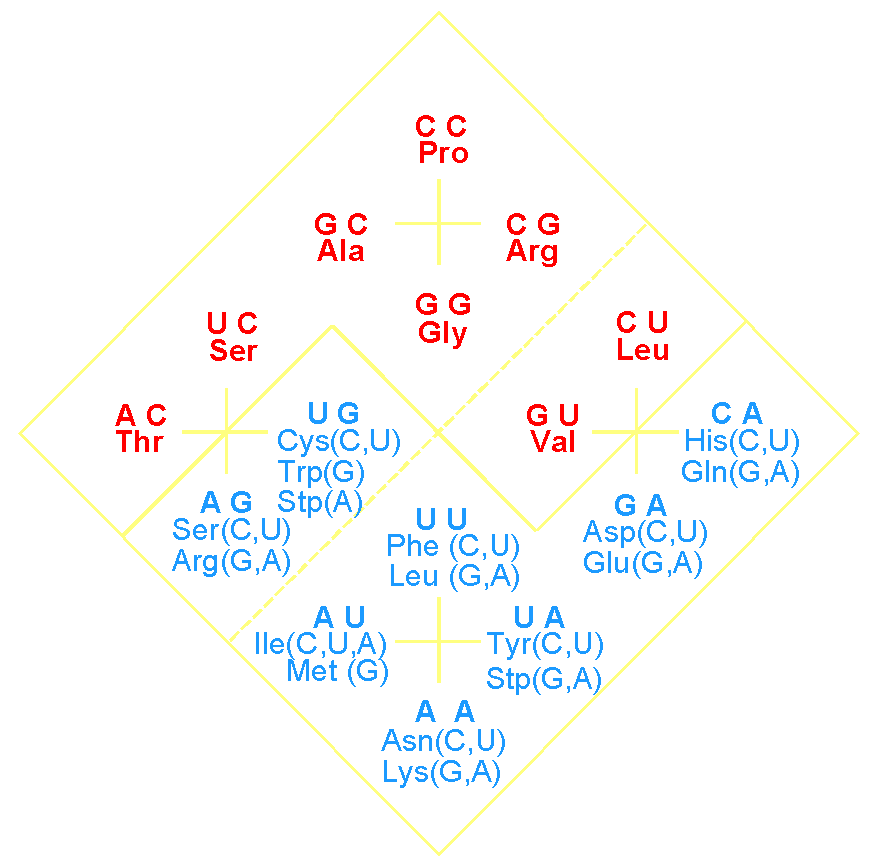2.1. Rhombic
variant of the genetic dictionary
|
Of course, you know, what is it? That's right, it's "Yin - Yang" - an ancient Chinese symbol of unity and conflict of opposites.
|
And this is a
rhombic variant of
the genetic dictionary
|
|
Fig. 1. The Ancient Chinese symbol «Yin - Yang». |
Fig. 2. A rhombic variant of the genetic dictionary based on the
complementarity of encoding
nucleotides (doublet genetic
code). |
|
The rhombic variant
of the genetic dictionary is similar to the "Yin-Yang",
isn’t it? "Rhombus"
is based on the complementarity
of encoding nucleotides [12]. Its prototype is the
regularities of structure of the doublet code, revealed
for the first time by Rumer [13]. Let's remind
the rules of complementarity:
|
The
remaining
doublets are obtained
as follows: - The first bases of doublets in the rows, going from top to bottom
from left to right, coincide with the
first base of the central
pairs, for example, rows with the
C and G by bases in the first position; - In series of doublets, going down from right to left, second base coincides with the second
base of the central pairs, for example, rows with the U and A bases in the second position. |
|
Properties of a doublet genetic code, which
are revealed by "Rhombus" |
|
|
1.
The presence of two groups of doublets |
2.
The relationship of the two groups
of doublets – Rumer’s transformation |
|
The rhombus
consists of two groups of doublets,
arranged compactly and symmetrically (group of
symmetry С2). In the group of 8 red doublets the third base
of a triplet can be any, i.e. completely degenerate
(so they are not shown in Figure 2).
In the group of 8
dark blue
doublets the first pair of the triplets coding, as a rule, the same amino acid, terminates by C, U, and the
second pair of
triplets coding for another
amino acid - by G, A. In Figure 2 they are shown in brackets in the first
and in the second lines for each amino acid. |
Each of the eight red doublets, coding for one amino acid is converted by the rule C <-> A, G <-> U (Rumer’s
transformation) into one of the dark blue
doublets, coding for the two values. In this case, as shown in Figure 1, doublets
connected by
Rumer’s
transformation, occupy in
"Rhombus" symmetrical
position, for example: AС < -- > CA, UC < -- > GA, GC < -- > UA, etc. |
|
3.
The compact arrangement of pairs of
doublets connected by complementarity |
4.
The compact arrangement of amino acids similar in structure |
|
Pair of doublets connected by parallel complementarity
(read in one direction, i.e. from left to right) have appeared against each other at the corners of a rhombus and have formed quartets (marked by cross),
for example:
UC < -- > AG, AC < -- > UG. The triplets associated by antiparallel complementarity
(are read in opposite directions) are in adjacent rows of the doublets going
down from right to left, for example: AUG < -- > CAU, UUU < -- > AAA etc. |
- short-chain amino acids: proline
(Pro), glycine
(Gly),
alanine (Ala),
serine, and (Ser),
threonine (Thr) cysteine
(
Cys) are close to the ranks of doublets with C and G in the second position; - non-polar amino acids: leucine (Leu),
valine (Val),
phenylalanine (Phe), isoleucine
(Ile), methionine
(Met) are situated compactly
in a series of doublets with U in the second position; -
polar amino acids: histidine (His),
glutamine (Gln), aspartic (Asp), glutamic
(Glu),
tyrosine (Tyr),
asparagine (Asn), lysine (Lys) are among the doublets with A in the second position. |
The listed properties, first of all, the Rumer’s
transformation, remain in all subsequent constructions, particularly in the spatial structure of the doublet code (section
2.2.).

